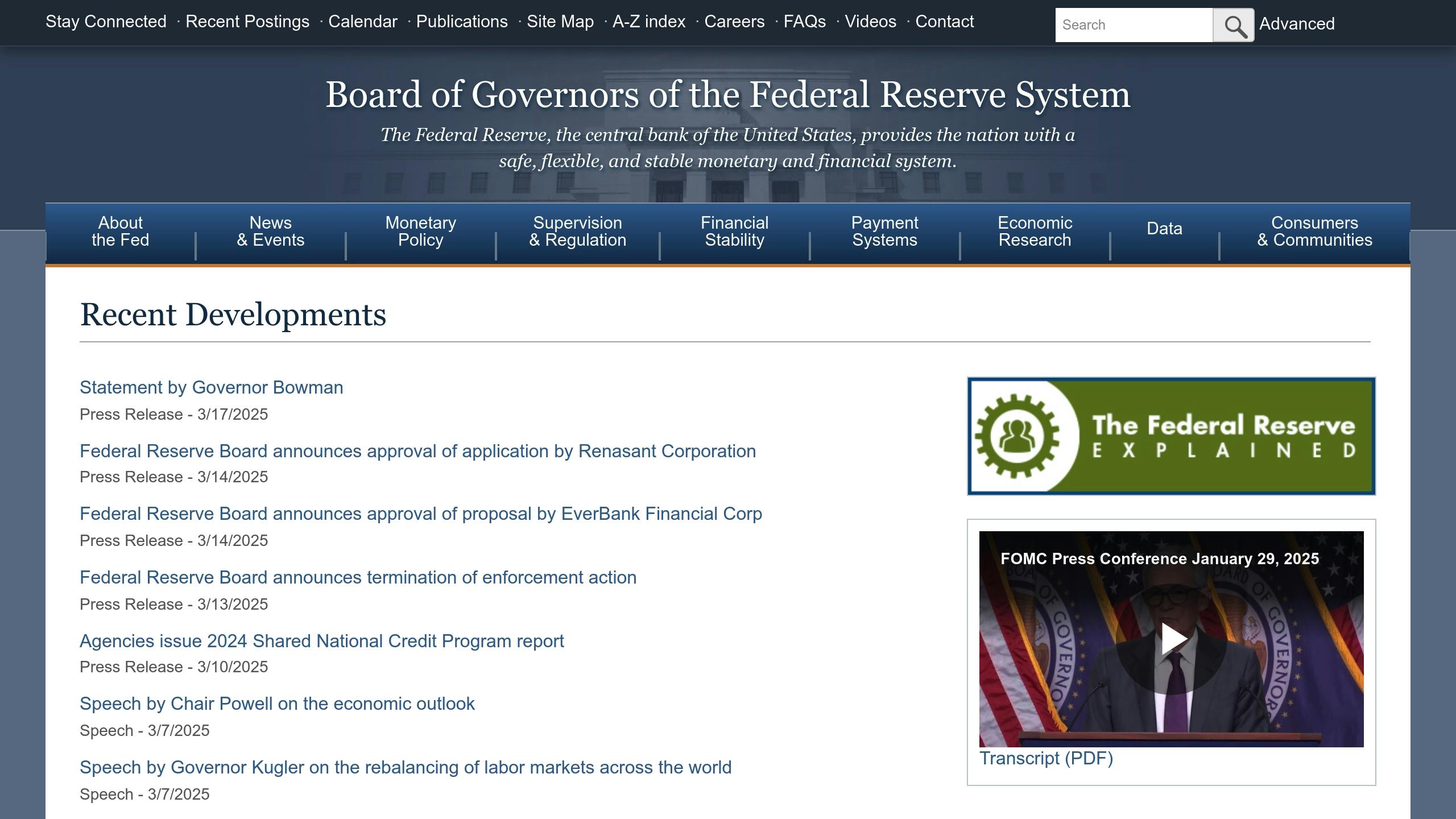Think the Federal Reserve directly controls mortgage rates? They don’t. Mortgage rates are influenced by multiple factors, such as bond markets, economic conditions, and lender-specific policies. Here’s a quick breakdown of what really drives mortgage rates:
- Bond Markets: Mortgage rates often follow the 10-year Treasury yield, with a typical spread of 1%-2%.
- Economic Data: Inflation, job growth, and GDP performance heavily impact rates.
- Lender Calculations: Rates are set based on funding costs, operating expenses, borrower risk, and profit margins.
- Borrower Factors: Your credit score, down payment, loan type, and property location all matter.
For instance, as of March 2025, the average 30-year fixed mortgage rate is 7.01%, driven by higher inflation and a widened spread between Treasury yields and mortgage-backed securities. Understanding these factors can help you secure better terms and make smarter financial decisions.
How 10 Year Treasury Yields Impact Mortgage Interest Rates
The Federal Reserve‘s Impact on Mortgage Rates
The Federal Reserve plays a key role in shaping lending markets, but its influence on mortgage rates is more complex than it might seem. While its decisions ripple through the financial system, mortgage rates aren’t directly set by the Fed.
How Fed Decisions Affect Short-Term Rates
The Fed controls the federal funds rate, which is the interest rate banks charge each other for overnight loans. This rate acts as a baseline for broader lending costs. Between March 2022 and July 2023, the federal funds rate jumped from 0.25%–0.50% to 5.25%–5.50% due to aggressive rate hikes. As a result, the average 30-year fixed mortgage rate rose from 4.17% in March 2022 to 6.54% in March 2023. For a $300,000 loan, this increase meant monthly payments went up by roughly $442 [2][3].
"The Federal Reserve doesn’t directly set mortgage rates. However, it can influence mortgage interest rates by adjusting the federal funds rate and buying or selling bonds and mortgage-backed securities."
– CNBC Select [4]
However, other factors often come into play, meaning mortgage rates don’t always follow the Fed’s lead.
When Mortgage Rates Move Independently
Mortgage rates can diverge from Fed-driven trends due to other market forces. For example, while mortgage rates typically follow the 10-year Treasury note with a spread of 1%–2%, that spread has recently widened to 2.5–3 percentage points [6].
Several factors contribute to this independence:
- Anticipated Fed Rate Changes: Lenders often adjust rates in anticipation of Fed policy shifts [5].
- Economic Indicators: Data like strong job growth or GDP performance can push rates higher, even if the Fed holds rates steady.
"I would argue that Federal Reserve monetary policy is the single most important factor that influences mortgage rates."
– Robert R. Johnson, professor at Heider College of Business, Creighton University [5]
Recent trends highlight this dynamic. In late 2024, despite the Fed keeping rates at 5.25%–5.50% for over a year, mortgage rates reacted more to inflation data – showing a 2.7% annual increase – and a November jobs report that added 227,000 positions [7][8]. This shows how economic conditions often overshadow Fed decisions in shaping mortgage rates.
sbb-itb-8115fc4
Market Forces That Set Mortgage Rates
The Federal Reserve sets short-term rates, but your mortgage rate is influenced by various market forces.
Bond Markets and Rate Setting
Mortgage rates are closely tied to the 10-year Treasury yield, maintaining a spread of about 2.25 percentage points above it [9]. Both mortgage-backed securities and Treasury notes attract similar long-term investors, creating this connection.
"Typically, when we see the 10‐year yield rise, we’d expect mortgage rates to increase"
– Emily Overton, capital markets analyst at Veterans United Home Loans [9]
Between January 2022 and November 2024, the spread between mortgage-backed securities and Treasury notes averaged 1.4 percentage points. This was much higher than the 0.71 percentage point average observed from 2012 to 2019 [1].
How Lenders Calculate Rates
Lenders use a cost-plus pricing model to set mortgage rates, factoring in various costs and risks. Here’s how it breaks down:
| Component | Description |
|---|---|
| Funding Costs | The cost of acquiring money |
| Operating Expenses | Day-to-day costs of running the lending business |
| Risk Premium | Adjustments based on the borrower’s financial profile |
| Profit Margin | Adjustments to stay competitive while ensuring profitability |
"Funding and operating costs, risk premium, target profit margin determine loan’s interest rate"
– Matthew D. Diette, Field Supervisory Examiner [10]
Competition among lenders also plays a role in keeping rates competitive, as banks adjust profit margins to attract borrowers.
Economic Data That Moves Rates
External economic factors also impact mortgage rates. Inflation is a key driver. For instance, when inflation hit 8.2% in September 2022 [11], lenders adjusted rates to ensure real returns on investments.
"Investors in the capital markets who buy mortgages need to be incented to purchase these assets. If the 10-year treasury rate goes up, mortgage rates go up as well, so the investment in mortgages is still an attractive option compared to investing in treasuries. Conversely, if treasury rates go down, mortgage rates will decrease"
– Jess Schulman, president of Bluebird Lending [9]
The Federal Reserve’s goal of 2% inflation helps maintain economic stability [11]. Other factors like employment data, GDP growth, and housing market trends also influence bond yields and, in turn, mortgage rates. Keeping an eye on these trends can help you make informed decisions about securing a mortgage.
Steps to Get Better Mortgage Rates
Best Times to Apply for a Mortgage
Timing your mortgage application wisely can lead to better rates and a smoother process. Lenders often provide better service at the start of the month, while closing at the end of the month might help reduce prepaid interest costs.
"The end of the month is often chaotic due to last-minute closings; apply between the third and fifth if possible, and get pre-approved by the 10th to 15th" – Herndon Davis, mortgage loan officer/broker [12]
To plan effectively, begin exploring mortgage options about four months before you start house hunting [12].
Rate Lock Basics
A rate lock secures your interest rate for a specific period, shielding you from market changes. Key factors to consider when deciding on a rate lock include:
| Factor | What to Aim For |
|---|---|
| Credit Score | A score of 740 or higher for the best rates |
| DTI Ratio | Keep your debt-to-income ratio under 36% |
| Down Payment | Putting down at least 20% to avoid PMI and get better rates |
| Employment History | Two or more years in the same field is preferred |
If you plan to sell or refinance before your rate adjusts, an adjustable-rate mortgage might be worth considering. Once your rate is locked, focus on improving your financial profile to secure competitive offers.
Getting the Best Rate Offers
Strengthening your financial position and comparing multiple offers are essential steps to securing a favorable mortgage rate.
"Negotiating can save you money. Your best bargaining chip is usually having Loan Estimates from other lenders in hand. Often, lenders are willing to match or beat their competitors’ offers." – Consumer Financial Protection Bureau [14]
Even a small rate improvement can lead to big savings. For instance, lowering your rate by just 0.5% on a $300,000 home with 20% down could save you roughly $80 per month, adding up to over $28,000 across a 30-year loan [17].
Here are some tips to help you get better rates:
- Check your credit reports for errors and fix them [15].
- Keep your credit utilization below 30% of your available credit [16].
- Get quotes from at least three different lenders [13].
- Consider buying points if you plan to stay in your home for the long term [17].
These strategies can help you navigate changing rates and make decisions that align with your financial goals and the housing market.
Conclusion: Making Smart Mortgage Decisions
Knowing what influences mortgage rates helps you make better choices when it comes to home loans. For instance, just a 20-point drop in your credit score can increase rates by 0.25%, adding up to about $12,000 in extra costs on a $250,000 loan [18].
Here are some key areas to focus on:
| Factor | Target Goal | Impact |
|---|---|---|
| Credit Score | 740+ | Access to the best rates |
| Down Payment | 20% or more | Avoid PMI and secure lower rates |
| DTI Ratio | Front-end: 28% or less | Better loan terms |
| Back-end: 36% or less | ||
| Rate Lock Duration | 30–60 days | Costs about 0.25% of the loan amount |
This table highlights the most important factors to address before finalizing your mortgage rate. Strive for a credit score of 740 or higher, save for a 20% down payment, and keep your debt-to-income (DTI) ratio below 36% to land the best rates.
If your budget permits, consider a 15-year mortgage. These shorter terms often come with lower rates and can save you a significant amount in interest over time [19]. As mentioned earlier, your rate is shaped by a mix of market conditions and lender policies.
Keep an eye on market trends, but don’t let them delay your plans to buy a home [20].
Related Blog Posts








